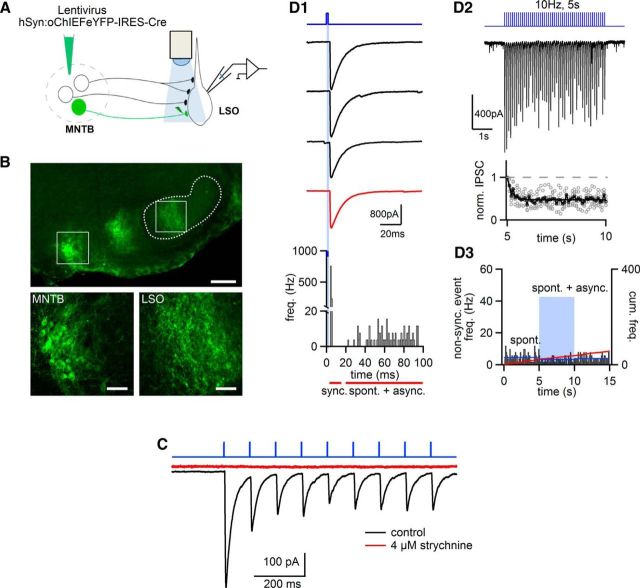Figure 3.
Optogenetic targeting and stimulation of MNTB-LSO synapses. A, Scheme of the lentiviral infection of MNTB neurons with a construct driving the expression of a light-activated ion channel (oChIEF) and Cre-recombinase (hSyn:oChIEFeYFP-IRES-Cre). The transfected fibers from Cre-expressing neurons are selectively amenable to optic stimulation. B, Confocal image of a brainstem slice of a P15 mouse on the level of the MNTB and LSO, 15 d after transfection. Bottom images, Higher-magnification images of the MNTB (left) and LSO (right), at the positions indicated in the top image (white squares). Scale bars: Top, 200 μm; Bottom, 50 μm. C, Optogenetically evoked IPSCs, here in response to a 10 Hz train, were blocked by bath application of 4 μm strychnine. D1–D3, Optogenetic stimulation experiment in an LSO slice of a P13 Syt1+/+, Syt2+/+ mouse, injected at P0 with the construct shown in A. D1, Three successively recorded IPSCs in response to the first optogenetic stimuli of 10 Hz trains (black traces). Red trace (here and in subsequent figures) represents the average of n = 10 successive trials. Bottom, Histogram of event frequency for 100 ms following the light stimuli (averaged over all 50 periods of the 10 Hz stimulus trains, and for n = 10 trains). Note the peak of synchronous events at the onset of stimulation. Spontaneous and asynchronous release events were detected at 20–100 ms following optical stimulation (see Materials and Methods). D2, A single IPSC train in response to a 10 Hz train. Bottom, Relative depression (normalized to the average first IPSC amplitude) for all 10 Hz trains in this recording (gray data points). The average depression time course (black data points) was fitted with an exponential function (black line). D3, Time course of spontaneous release frequency before and after the train, and of asynchronous and spontaneous release during the 10 Hz optogenetic trains. Red line indicates cumulative event frequency (see right axis). Blue lines indicate averages of the release frequencies during the three different 5 s intervals.

